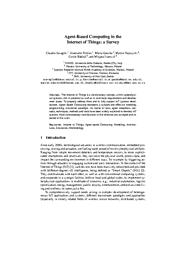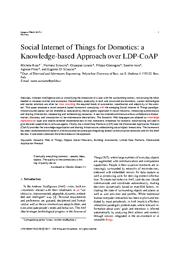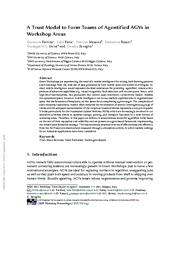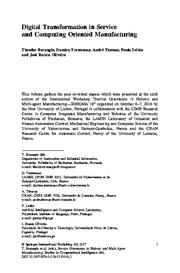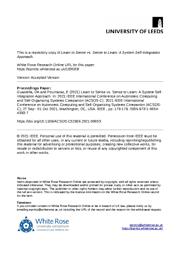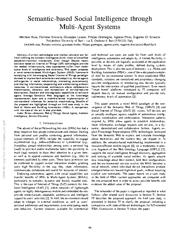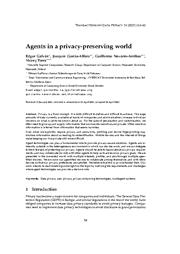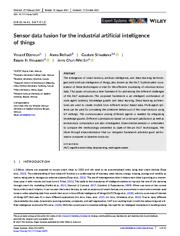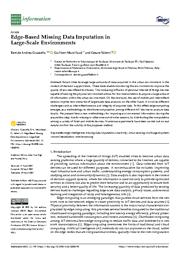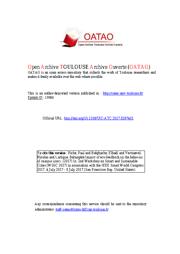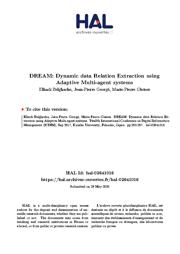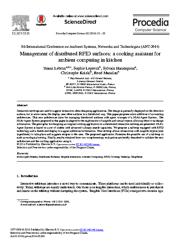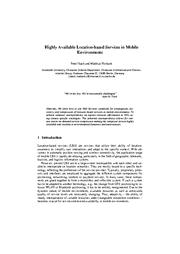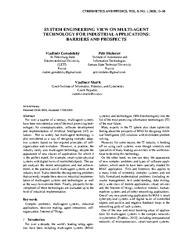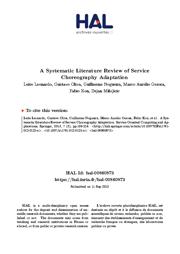A copy of this work was available on the public web and has been preserved in the Wayback Machine. The capture dates from 2019; you can also visit the original URL.
The file type is application/pdf.
Filters
Agent-Based Computing in the Internet of Things: A Survey
[chapter]
2017
Studies in Computational Intelligence
The Internet of Things is a revolutionary concept, within cyberphysical systems, rich in potential as well as in multifacet requirements and development issues. ...
To properly address them and to fully support IoT systems development, Agent-Based Computing represents a suitable and effective modeling, programming, simulation paradigm. ...
It was supported in part by PAS-RAS bilateral project "Semantic foundation of the Internet of Things", as well as a collaboration agreement between University of Novi Sad, University of Craiova, SRIPAS ...
doi:10.1007/978-3-319-66379-1_27
fatcat:bsdipjsxgfczjek6kuwopzoneq
Social Internet of Things for domotics: A knowledge-based approach over LDP-CoAP
2018
Semantic Web Journal
This paper proposes a novel semantic-based framework complying with the emerging Social Internet of Things paradigm. ...
Experiments advocate the effectiveness of the approach. Eventually everything connects -people, ideas, objects. The quality of the connections is the key to quality per se. ...
Recent research in the so-called Social Internet of Things [5] is starting to define models and architectures to reach this goal. ...
doi:10.3233/sw-180299
fatcat:sc4woa3lfrahnkf4lffgqcicue
A Trust Model to Form Teams of Agentified AGVs in Workshop Areas
2021
Workshop From Objects to Agents
It holds particularly for the Automated Guided Vehicles (AGVs) which are increasingly involved in collaborative activities aimed to optimise storage, picking, and transport functions in a wide variety ...
Therefore, in this paper we define a trustworthiness model for agentified AGVs based on the mix of their reputation and reliability and we present an agent-based framework implementing the related team ...
Therefore, the formation of temporary teams of heterogeneous AGVs is widely seen as an important advancement within the Industrial Internet of Things (IIoT) domain [1, 2, 3, 4] . ...
dblp:conf/woa/FortinoFMRSS21
fatcat:na7q4ucpazamhpihl2ogdtax7a
Digital Transformation in Service and Computing Oriented Manufacturing
[chapter]
2017
Studies in Computational Intelligence
of Things, (iii) Taking smart decisions in production management and control by distributing intelligence among multi-agent systems (MAS) acting as information counterparts of physical assets, and orchestrating ...
or composite manufacturing services (how to access and invoke such services). ...
doi:10.1007/978-3-319-51100-9_1
fatcat:xrjznuzg4jf6laue6pvwlutho4
Learn to Sense vs. Sense to Learn: A System Self-Integration Approach
2021
2021 IEEE International Conference on Autonomic Computing and Self-Organizing Systems Companion (ACSOS-C)
The diffusion of Internet of Things (IoT) devices has opened up new opportunities for decentralized data analytics. ...
In this paper, we propose a new self-integration approach to improve the performance of decentralized self-healing techniques. ...
The latter is a complex task because it is hard to attribute how an agent's individual action influences to a global aggregation result. ...
doi:10.1109/acsos-c52956.2021.00053
fatcat:xz7ijgnv5faipd6mxauaxkifea
Semantic-based Social Intelligence through Multi-Agent Systems
2018
Workshop From Objects to Agents
This paper proposes a novel semantic-based Multi-Agent System (MAS) framework complying with the emerging Social Internet of Things paradigm devoted to improve both automation and adaptivity: device agents ...
Even though Despite recent solutions based on Internet of Things (IoT) technologies provide the needed infrastructure, most approaches suffer from inadequate levels of intelligence and autonomy. ...
The approach proposed in this paper is conceptually close to [5] , where SIoT has been envisioned as a social evolution of the Internet of Things, with agentified objects capable of setting mutual relationships ...
dblp:conf/woa/RutaSLGPS18
fatcat:4kmizi4purhvvdsxmvrld5xxbi
Agents in a privacy-preserving world
2021
Transactions on Data Privacy
Mobile devices and the internet of things make keeping our live private still more difficult. Agent technologies can play a fundamental role to provide privacy-aware solutions. ...
We are presented in the connected world with multiple interests, profiles, and also through multiple agentified devices. ...
For instance, Internet of Things is increasing the number of personal devices connected to the internet. These devices are highly heterogeneous. ...
dblp:journals/tdp/GalvanGNT21
fatcat:a5n6s75izzbntiwplkszu32nom
Sensor data fusion for the industrial artificial intelligence of things
2021
Expert systems
Experimental analysis is undertaken to compare the methodology presented to state-of-the-art AIoT technologies. ...
Deep learning architectures are used to create models from different sensor-based data. ...
in the whole internet of things system. ...
doi:10.1111/exsy.12875
fatcat:n7i3kdy23rbh7lsxohc3vkgive
Edge-Based Missing Data Imputation in Large-Scale Environments
2021
Information
The increasing diffusion of personal Internet of things devices capable of sensing the physical environment allows for low-cost solutions to acquire a large amount of information within the urban environment ...
These tools enable monitoring the environment to improve the quality of services offered to citizens. ...
Conflicts of Interest: The authors declare no conflict of interest. ...
doi:10.3390/info12050195
fatcat:wgi5snp7szff7ihhbdlzale73a
Impact of eco-feedback on the behavior of campus users
2017
2017 IEEE SmartWorld, Ubiquitous Intelligence & Computing, Advanced & Trusted Computed, Scalable Computing & Communications, Cloud & Big Data Computing, Internet of People and Smart City Innovation (SmartWorld/SCALCOM/UIC/ATC/CBDCom/IOP/SCI)
A multidisciplinary solution is given to improve the impact of the eco-feedbacks on users. ...
We propose a review of articles dealing with the behavior change of users due to the setting-up of an eco-feedback system on university campuses. The main building types studied are dormitories. ...
by a network of sensors and connected devices (Internet of Things or IoT), and therefore present meaningful eco-feedback (focus on relevant correlations) to help the users find where and how they can ...
doi:10.1109/uic-atc.2017.8397401
dblp:conf/uic/PicheBVL17
fatcat:2f7pjkqazfayznkwf4pg64hgci
DREAM: Dynamic data relation extraction using adaptive multi-agent systems
2017
2017 Twelfth International Conference on Digital Information Management (ICDIM)
appearance of some clusters (figure 8) In the scope of ambient systems, Internet of Things and Smart Cities, our system can provides extra features: • Anomaly detection: when all the relations of one ...
feedback to help the users find where and how they can save energy [13] . ...
doi:10.1109/icdim.2017.8244684
dblp:conf/icdim/BelghacheGG17
fatcat:4f3zs3z4tnco7fa4jnbksxsrdi
Management of Distributed RFID Surfaces: A Cooking Assistant for Ambient Computing in Kitchen
2014
Procedia Computer Science
The Multi-Agent System proposed in this paper is adapted to the exploitation of tangible and virtual objects allowing them to exchange information. ...
This tabletop allows interactions with tangible objects (real ingredients) to take place and suggests recipes to the user. ...
The authors would like to thank the partners with whom we collaborated on the TTT and IMAGIT projects: LIG, RFIdees and the CEA. ...
doi:10.1016/j.procs.2014.05.393
fatcat:oyfsldwgl5br7inx7z6wi5d3u4
Highly Available Location-Based Services in Mobile Environments
[chapter]
2005
Lecture Notes in Computer Science
We show how to use Web Services standards for propagation, discovery, and composition of location-based services in mobile environments. ...
The achieved interoperability allows for context-aware on-demand service composition making the composite service highly available and resilient to environmental dynamics and uncertainties. ...
An "Internet of things" [1] with billions and soon trillions of seamlessly interconnected devices is about to take over the era of traditional computers and computer networks. ...
doi:10.1007/978-3-540-30225-4_10
fatcat:jrdw4q3isffgpn4j2m4f5alrkq
System engineering view on multi-agent technology for industrial applications: barriers and prospects
2020
Cybernetics and Physics
Finally, prospects for development of these technologies are evaluated up to the level of industrial implementation. ...
It also identifies the engineering problems that currently impede the extensive industrial implementation of multi-agent systems and technologies as well as the ways to overcome them. ...
Acknowledgements The work was supported by the Ministry of Education and Science of the Russian Federation within the framework of contract agreement No. 14.574.21.0183 -the unique ID number is RFMEFI57417X0183 ...
doi:10.35470/2226-4116-2020-9-1-13-30
fatcat:g54clig6k5bxbezaqrkmxnue4i
A systematic literature review of service choreography adaptation
2012
Service Oriented Computing and Applications
Acknowledgements The research leading to these results has received fund- ...
The authors identify scalability as a issue to be tackled in the very-large-scale Internet of Things context. ...
[6] aim to bridge physical and Internet world by exploring service orchestration and choreography undertaking scalability and dinamicity issues of Internet of Things. ...
doi:10.1007/s11761-012-0125-z
fatcat:r42gev2cjvg4vljovqtiotisaq
« Previous
Showing results 1 — 15 out of 22 results

